
Holy Family with the Infant John the Baptist and a Donor is an oil painting on panel executed c. 1528 by the Italian Renaissance painter Domenico Beccafumi. It is a tondo measuring 140 cm in diameter, and is now in the Museo Horne in Florence.

Holy Family with the Infant John the Baptist and a Donor is an oil painting on panel executed c. 1528 by the Italian Renaissance painter Domenico Beccafumi. It is a tondo measuring 140 cm in diameter, and is now in the Museo Horne in Florence.
The work was purchased by the Horne Foundation after the death of its founder, in 1934, when there was the Bengujat auction of the furnishings of the Davanzati Palace. The tondo was probably previously owned by the Marquises Durazzo Spinola of Genoa. [1]
Stylistically close to San Michele in the Church of San Nicolò al Carmine, it shares an approach similar to other works, such as the one in the Doria Pamphili Gallery or the one in the Marri Mignanelli Collection in Sinalunga.
The space of the tondo is exploited to perfection by the sacred group, centered on the figure of the Child who opens a book in the hands of a man, probably the client, to whom he also turns an intense gaze. Jesus is in the hands of Mary seated and on the left appear Joseph, emerging from the shadows, and St. John, recognizable by the bowl with which he carried out the baptism. The intertwining of gestures and glances between the figures recalls the classical models of Raphael and the Florentine painters, combined with Beccafumi's very particular sense of color and light. [2]
The carved frame with high-relief heads recalls that of the Tondo Doni and refers to the activity of Giovanni Barilli.

Mariotto di Bindo di Biagio Albertinelli was an Italian Renaissance painter active in Florence. He was a close friend and collaborator of Fra Bartolomeo.
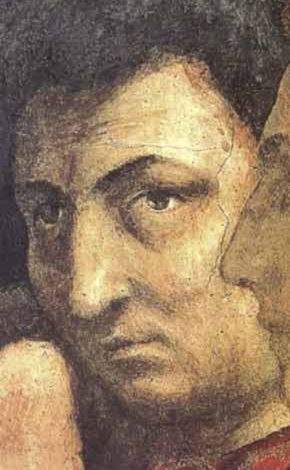
Masaccio, born Tommaso di Ser Giovanni di Simone, was a Florentine artist who is regarded as the first great Italian painter of the Quattrocento period of the Italian Renaissance. According to Vasari, Masaccio was the best painter of his generation because of his skill at imitating nature, recreating lifelike figures and movements as well as a convincing sense of three-dimensionality. He employed nudes and foreshortenings in his figures. This had seldom been done before him.

Alessandro di Mariano di Vanni Filipepi, better known as Sandro Botticelli or simply Botticelli, was an Italian painter of the Early Renaissance. Botticelli's posthumous reputation suffered until the late 19th century, when he was rediscovered by the Pre-Raphaelites who stimulated a reappraisal of his work. Since then, his paintings have been seen to represent the linear grace of late Italian Gothic and some Early Renaissance painting, even though they date from the latter half of the Italian Renaissance period.

Antonio Allegri da Correggio, usually known as just Correggio was an Italian Renaissance painter who was the foremost painter of the Parma school of the High Italian Renaissance, who was responsible for some of the most vigorous and sensuous works of the sixteenth century. In his use of dynamic composition, illusionistic perspective and dramatic foreshortening, Correggio prefigured the Baroque art of the seventeenth century and the Rococo art of the eighteenth century. He is considered a master of chiaroscuro.

Filippino Lippi was an Italian painter working in Florence, Italy during the later years of the Early Renaissance and first few years of the High Renaissance.

The Pietà is a subject in Christian art depicting the Blessed Virgin Mary cradling the mortal body of Jesus Christ after his Descent from the Cross. It is most often found in sculpture. The Pietà is a specific form of the Lamentation of Christ in which Jesus is mourned by sole privilege of the Virgin Mary alone, while representing her "sixth sorrow" and sometimes accompanied by a specific Marian title.

Il Sodoma was the name given to the Italian Renaissance painter Giovanni Antonio Bazzi. Il Sodoma painted in a manner that superimposed the High Renaissance style of early 16th-century Rome onto the traditions of the provincial Sienese school; he spent the bulk of his professional life in Siena, with two periods in Rome.

Benozzo Gozzoli was an Italian Renaissance painter from Florence. A pupil of Fra Angelico, Gozzoli is best known for a series of murals in the Magi Chapel of the Palazzo Medici-Riccardi, depicting festive, vibrant processions with fine attention to detail and a pronounced International Gothic influence. The chapel's fresco cycle reveals a new Renaissance interest in nature with its realistic depiction of landscapes and vivid human portraits. Gozzoli is considered one of the most prolific fresco painters of his generation. While he was mainly active in Tuscany, he also worked in Umbria and Rome.

Domenico di Pace Beccafumi was an Italian Renaissance-Mannerist painter active predominantly in Siena. He is considered one of the last undiluted representatives of the Sienese school of painting.

Lorenzo di Credi was an Italian Renaissance painter and sculptor best known for his paintings of religious subjects. He is most famous for having worked in the studio of Andrea del Verrocchio at the same time as the young Leonardo da Vinci.

Giovanni Antonio Sogliani was an Italian painter of the Renaissance, active mainly in Florence.

Bastiano di Bartolo Mainardi (1466–1513) was an Italian painter of the Early Renaissance. He was born in San Gimignano and was active there and in Florence.

The Virgin and Child with the Infant Saint John the Baptist is a tempera painting on wood executed by the Italian Renaissance master Sandro Botticelli and his studio. The tondo, painted in Florence between the years of 1490 and 1500, addresses a central theme of the Italian Renaissance art: the divine motherhood. The work is now in the São Paulo Museum of Art.
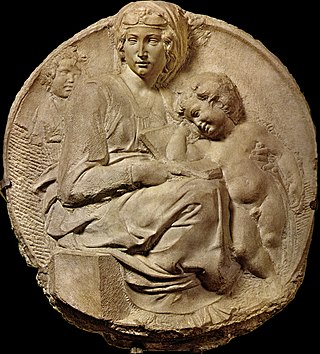
The Pitti Tondo is an unfinished marble relief of the Virgin and Child by Michelangelo in round or tondo form. It was executed between 1503 and 1504 while he was residing in Florence and is now in the Museo nazionale del Bargello in Florence.
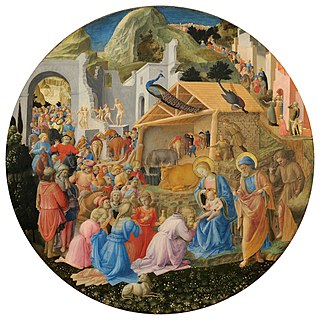
The Adoration of the Magi is a tondo, or circular painting, of the Adoration of the Magi assumed to be that recorded in 1492 in the Palazzo Medici Riccardi in Florence as by Fra Angelico. It dates from the mid-15th century and is now in the National Gallery of Art in Washington D.C. Most art historians think that Filippo Lippi painted more of the original work, and that it was added to some years after by other artists, as well as including work by assistants in the workshops of both the original masters. It has been known as the Washington Tondo and Cook Tondo after Herbert Cook, and this latter name in particular continues to be used over 50 years after the painting left the Cook collection.

Deucalion and Pyhrra is an oil painting on panel of c. 1520–1525 by the Italian Renaissance painter Domenico Beccafumi. It is held now in the Museo Horne, in Florence.

Putti Bearing a Tondo Showing the Drunkenness of Noah is an oil painting on panel executed c. 1522–1523 by the Italian Renaissance painter Domenico Beccafumi.
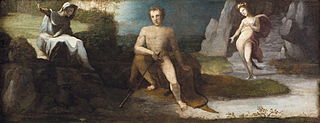
The Choice of Hercules or Hercules at the Crossroads is an oil painting on canvas executed c.1520–1525 by the Italian Renaissance painter Domenico Beccafumi. It is now in the Museo Bardini in Florence. It is strongly influenced by Baldassarre Peruzzi's frieze at the Villa Farnesina, placing it after Beccafumi's possible trip to Rome around 1512.
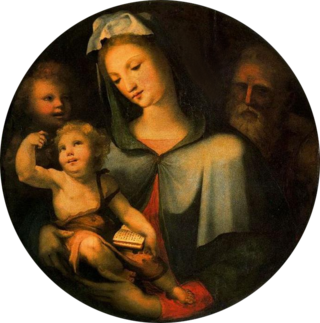
Holy Family with the Infant Saint John the Baptist is an oil-on-wood painting by the Italian Mannerist painter Domenico Beccafumi, executed c. 1514–1515, now in the Uffizi in Florence.

Holy Family with the Infant Saint John the Baptist is an oil-on-canvas painting by the Italian Renaissance painter Domenico Beccafumi, executed c. 1521–1522, now in the Galleria Palatina in Florence. The painting's composition is strongly influenced by Raphael. The seraphim in the four corners of the work are thought to be later additions by a Sienese artist, possibly at the end of the 16th century – Judey attributes them to an artist in the circle of Correggio and Sanminiatelli to a generic Baroque-influenced Sienese artist.